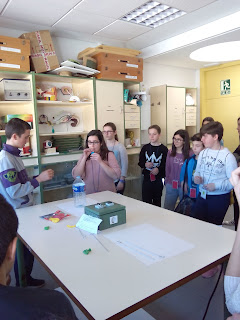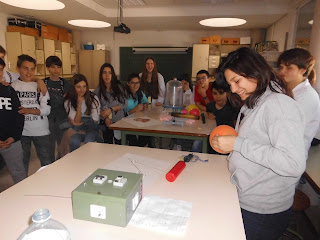Se realizaron un total de 10 experimentos, cada uno explicado por un alumno al resto del auditorio. Como no podía ser de otra manera, los alumnos arrancaron los aplausos de los asistentes en todos los casos.
Os dejo una reseña de los experimentos realizados con la redacción en inglés y una galería con las fotos. Lo pasamos genial, ¿verdad chicos?
1. IS IT EASY
TO BLOW A BALLOON?
·
You want to blow a balloon inside a
bottle.
·
Try...
·
What has happened?
·
Is it possible?
·
No, it isn’t
·
But....I can
·
If you make a small hole in the
bottle, the air can go outside and the balloon can be blown inside.
2. BALLOON BROCHETTE
·
Blow a balloon and knot it.
·
You want to go through the balloon
with this brochette.
·
Is it possible?
·
Try...
·
But...I can
·
What has happened?
·
The balloon doesn’t explode because
the spike is introduced where the plastic is not very tense.
·
The air doesn’t escape from the
inside of the balloon.
·
If we remove the brochette, the
balloon will deflate slowly.
3. HIDING BALLOON
·
Blow a small balloon.
·
Put ten matches lit into a glass
bottle.
·
Wait a little and place the balloon
on top of the bottle neck.
·
What has happened?
·
The balloon passes through the bottle
after the combustion of matches.
·
Carbon dioxide and water vapour can
get the air out of the bottle.
·
A vacuum is created which causes the
suction of the balloon.
4. MAGIC BELL
·
This is a vacuum bell.
·
When you remove the air that exists
inside, a vacuum is generated and the bell sticks to the base.
·
Atmospheric pressure keeps the bell
stuck to its base.
·
Place two little balloons inside the
vacuum bell.
·
Eliminate the air with the hand pump.
·
What has happened?
·
The balloon increases its size.
·
This is a demonstration of Boyle’s
Law.
·
A decrease in pressure implies an
increase in volume.
·
This can be made with sweets too.
5. A BALLOON THAT DOES NOT EXPLODE.
·
Blow two balloons, one with air and
one with water.
·
If you approach the balloon full of
air to the flame explodes immediately.
·
Now, I need a volunteer.
·
If you approach the balloon full of
water to the flame we can see that it does not explode.
·
What has happened?
·
The temperature of the balloon with
water increases but the water absorbs a lot of energy and does not let the
temperature rise more than 100ºC (one hundred degrees centigrade).
6. THE THIRSTY BALLOON
·
Blow a balloon.
·
Rub the balloon with head hair.
·
Hairs are repulsed because they
acquire the same electrical charge.
·
Balloon attracts hairs because they
have different electrical charge.
·
Approach the balloon charged to a
thin stream of water.
·
The balloon attracts water because
they have different electrical charges.
7. CAN RACE
·
Blow the balloon.
·
Rub the balloon against the hair.
·
Place the can lying on a table and
approach the balloon.
·
The can moves.
·
What has happened?
·
The balloon is charged with
electricity.
·
The can rotate due to attractive electrical
forces.
8. FAQUIR BALLOON
·
Blow the balloon.
·
I need glasses to protect my eyes.
·
Push the balloon against some 20 tacks.
·
What has happened?
·
It does not explode.
·
The force is distributed over all the
tacks and there was not enough pressure so that they could explode the balloon.
·
Push the balloon against a single tack.
·
What has happened?
·
The balloon explodes.
·
The force is concentrated at a very
small point and the pressure causes the tack traverse the balloon and it explodes.
9. THE DESCARTES TOY
·
Fill a bottle of water.
·
Introduce a blister with a little
water inverted.
·
Place a balloon on the neck of the
bottle
·
Press the balloon.
·
What has happened?
·
The blister drops because it weighs
more as more water enters when we press the balloon.
·
This is a demonstration of the Pascal’s
Principle.
10. THE KILLER ORANGE
·
Blow a balloon.
·
Take an orange, dry it and peel it.
·
Break a piece of peeling next to the
balloon.
·
What has happened?
·
In the orange peeling there are
essential oils (limonene) which are able to explode the balloon.






































Mucho trabajo lleva todo lo que habéis hecho. Enhorabuena!!!
ResponderEliminar